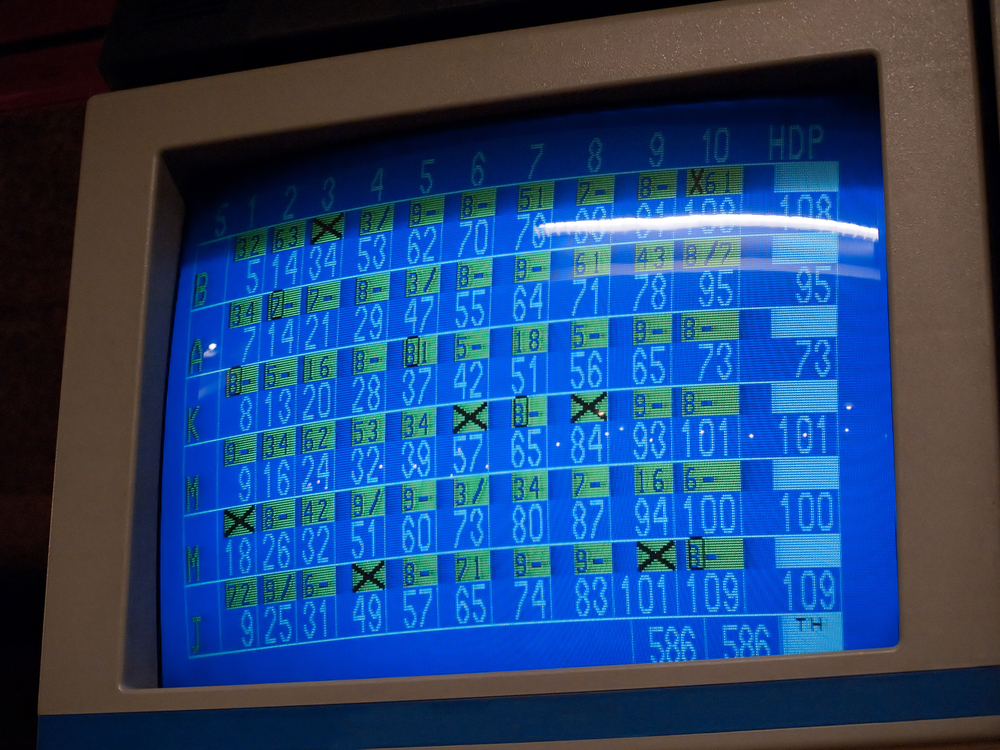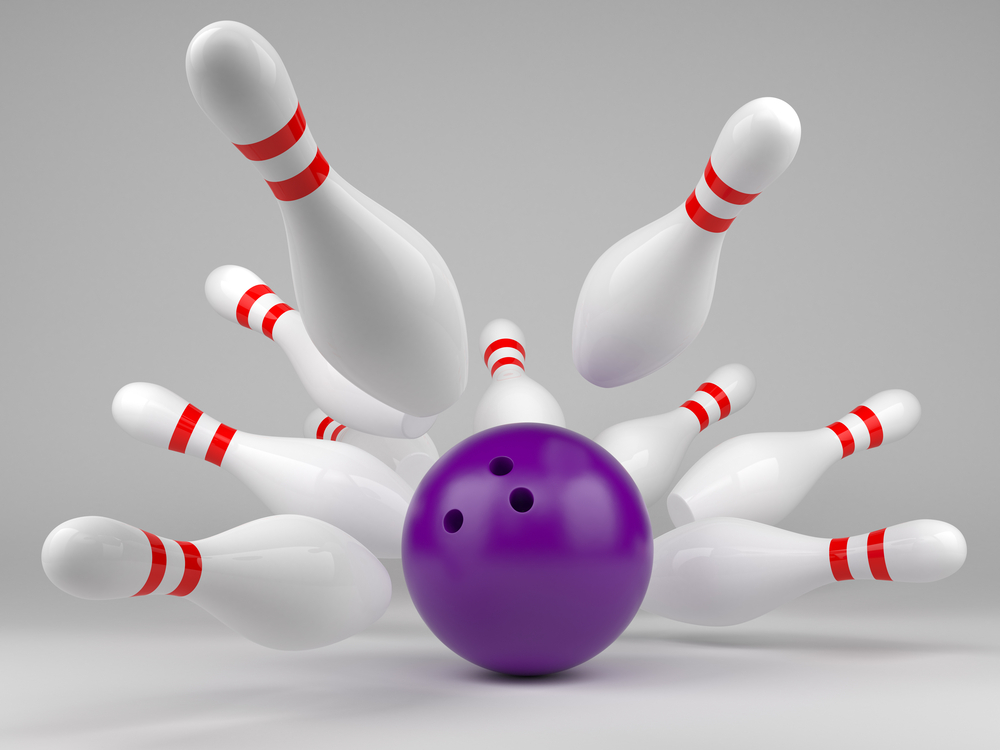
After bowling their first game, many new bowlers wonder how they did. The answer isn’t always very clear. There’s a lot to familiarize yourself with when it comes to bowling scores, and we’re here to help. This article will look at what makes a good bowling score and help you determine a good bowling average you should strive for.
Contents
What Is a Good Bowling Score?
A good bowling score varies depending on your experience level and whether you are a beginner, casual, intermediate, or professional bowler. It’s a lot of information to digest, so we’ll break things down below.
For Beginners/First-Time Bowlers
For first-time bowlers, a score of 50 to 70 is considered good. While some will score lower on their first few games, it’s rare for anyone to bowl less than a 50 consistently.
Don’t worry about it if you don’t score well at first. Instead, focus on getting used to the feeling of playing and improving your rolls.
For Casual Bowlers
After their first few games, most bowlers fall into the casual or recreational category. Casual bowlers have had a little practice and time to develop their technique.
A good average bowling score for casual bowlers is 70 to 100 points, although some may score higher or lower depending on how often they’ve played.
For Intermediate Bowlers (Non-league)
You'll need to consistently score between 130 and 170 to be considered a good intermediate bowler. Good bowlers are moderately skilled and are comfortable with their form and technique.
When you reach this level, you start to see a rise in strikes and spares, which helps contribute to an overall higher score.
For Professional Bowlers
A professional bowler is someone who makes a living by bowling. They’re dedicated, experienced, and considered the best in their field. Professional bowlers should look to score at least 200 to 250 points per game, although the higher the score, the better.
In addition to being more skilled, professional bowlers tend to score higher because they invest in specialized balls, shoes, and accessories.
How Scoring Works in Bowling

Bowling has a simple, straightforward point structure. There are ten frames during a game of bowling. For each frame, you’ll have two opportunities to knock down as many bowling pins as possible with a bowling ball.
The more pins you knock over, the higher your score. Every pin you knock down earns one point, but you can also earn bonus points by getting strikes and spares.
For anyone unfamiliar with bowling terms, a spare is when you knock down all ten pins after throwing two bowling balls. After getting a spare, you’ll be awarded 10
points plus the total from your next shot.
On the other hand, a strike is when you knock all the pins down on your first try. If you get a strike, you’ll get 10 points plus the total from your next two shots.
Your score will be recorded on a scorecard. Various symbols and numbers indicate how many pins you knocked down during each roll.
- An “X” denotes a strike.
- A “/” shows that you got a spare.
- A “-” shows that you didn’t hit any pins during the frame.
- Other symbols include “F” for foul, “O” or “S” for a split.
What’s a Perfect Score in Bowling?
Although a game of bowling is comprised of only ten frames, getting a strike in the last round earns you two more shots for a total of 12 shots.
If you play a perfect game and get a strike in all twelve rounds, you'll reach the maximum score of 300 points. It's the highest possible score in a game.
If you were wondering, the highest score you can achieve in a game without getting any strikes is 190.
Getting twelve strikes in a row is difficult. It takes both a high level of skill and luck. While twelve strikes is a perfect game, there are other terms for getting a series of strikes in a game.
The name depends on the number of consecutive strikes you get in a row. We’ll break them down below.
- One strike - Strike
- Two strikes in a row - Double
- Three strikes in a row - Turkey or triple
- Four strikes in a row - Hambone or four-bagger
- Five strikes in a row - Yahtzee or five bagger
- Six strikes in a row - Six pack or Wild Turkey
- Seven strikes in a row - Front seven or seven bagger
- Eight strikes in a row - Front eight or eight bagger
- Nine strikes in a row - Front nine or nine bagger
- Ten strikes in a row - Front Ten or ten bagger
- Eleven strikes in a row - Front eleven or eleven bagger
- Twelve strikes in a row - A perfect game
The Bowling Average
You can calculate average scores by adding up the scores from all of your games and then dividing that number by the total number of games you played. Your bowling average helps determine your handicap, which is how league bowlers will match you against other players.
When you join a bowling league, your average will be calculated weekly. That means every game you play in a season counts towards your overall bowling average.
Bowling Averages to Strive For
Now that you know what a bowling average is and how to calculate it, you’re probably wondering what makes a good one. This section will discuss the bowling average each skill level should aim for.
Beginner/First Time Bowler Average
Don’t worry about your average too much when you first start bowling. The United States Bowling Congress won’t even recognize a player's bowling average until they’ve played a minimum of twelve games. Once you’ve got a few games under your belt, aim for a bowling average of at least 70 points.
Casual Bowler Average
After you’ve started bowling more often, you should see your bowling average increase. As the fundamentals become second nature, try to strive for a bowling average between 100 and 130 points.
Just keep practicing, and your score should continue to improve with each game. You can also watch professional bowlers and try to pick up tips on form.
Good Bowler (Non-league bowler) Average
Once you’ve played many games, you should start to get the hang of things. By this point, your posture and technique have improved, and you might even start investing in some personal bowling equipment.
At this point, you should try to maintain an average of 140 to 175 points. Try to increase the number of strikes and spares you earn during each game, and your bowling average should continue to rise.
College Bowler Average
The competition on the collegiate level is fierce. It takes a tremendous amount of dedication, self-work, and teamwork to make the season a success. To stay on par with the competitiveness of our team and other schools, you should strive to maintain a college bowling average of 169 to 180 points.
Professional Bowler Average
Professional bowlers have perfected their rolling technique and form and spend significant time practicing their craft. To stay competitive, professional bowlers should try to maintain a bowling average of 200 to 250 points.
Anything above 200 is considered excellent, so that should be your minimum goal. Once you consistently get 200+ points per game, you’ll have a much easier time earning sponsorships, endorsements, and business opportunities.
Related Articles
We hope this article answered all your questions and helped explain what makes a good bowling score. To sum things up, there is no universal score that’s good for everyone. It depends on your experience level, and the more you play, the better you’ll score.
If you only bowl casually, the most important thing to do is have fun. If scoring high is important to you, practice as much as possible. You’ll be bowling like a pro in no time! We wish you the best of luck!
Kira Byrd, a Certified Fraud Examiner, holds a B.S. in Accounting from the University of Alabama at Birmingham. With a passion for bowling from her childhood, Kira has poured her expertise and personal experiences into creating and nurturing Bowling For Beginners. Kira's mission is to meet new bowlers where they are and guide them toward consistently achieving higher scores. With a focus on skill development and strategic techniques, she empowers readers to take control of their game and unlock their true potential.
Bowling For Beginners embodies strict editorial integrity, ensuring reliable and unbiased information. Kira's commitment to delivering valuable insights and practical strategies is reflected in every article. Here's an explanation of our editorial policy and how we get money.





